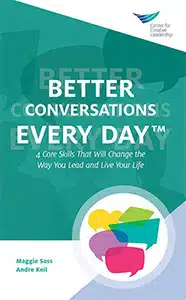Take a moment and ask yourself these 2 questions:
First, do you believe you have more potential than your current performance level? And if yes, what’s the opportunity cost of not using that potential more often?
If you think like the overwhelming majority of the senior executives, then you answered yes to the first question, and “a lot of time and money” for the second.
This is problematic on a variety of fronts, and coaching has proved to be one of the best means of addressing it. Executives need support, and coaching helps leaders achieve their personal best, swiftly adjust to the demands of their environment, and expand their personal level of impact.
If you lead a human resources department, you need to think about how you can create a culture of coaching that will help your entire organization reach its potential.
What’s a Coaching Culture?
Building a coaching culture involves focuses on shifting unwritten rules, values, norms, behaviors, and practices to spread a coaching mindset and coaching practices throughout the organization so that coaching becomes a key part of the company’s identity. A coaching culture improves not only the way employees interact with each other, but also the interactions they have with customers and potential clients.
A coaching culture enables radical organizational transformation by building conversational and coaching skills on a daily basis. A coaching culture creates a climate where people can freely:
- Give and receive feedback;
- Support and stretch each other’s thinking;
- Challenge each other with support, and stress-test ideas where appropriate; and
- Engage in development conversations that are short in length, but strong in impact.
In short, a better culture starts with better conversations.

Learn how to communicate better, connect more deeply, build trust, and be more satisfied — inside and outside of work — with our book, Better Conversations Every Day.
How to Instill a Coaching Culture
3 Steps for Leaders
Here are 3 steps to consider for deploying a coaching culture.
1. Make the case for strengthening coaching skills by allowing key influencers to experience its power.
Don’t assert the value of coaching. Instead, demonstrate its value, particularly in situations that are painful for the business leaders. You want the influencer to be able to say something like: “I’ve been struggling with this for the last 3 weeks. It’s amazing that in only 30 minutes with you, I’ve found alternative ways of handling this. I have newfound confidence!”
2. Integrate coaching as a core element of your talent and leadership development strategy.
Before trying to embed coaching in your culture, start by integrating coaching into your leadership and talent development framework. Embed coaching in some of your leadership programs for targeted populations, like high potentials, senior managers, and senior experts. It’s the equivalent of learning how to walk before you run. It also exposes your organization to a critical mass of adopters.
3. Equip key leaders, including HR professionals, with coaching conversation skills.
The ideal situation arises when business leaders and HR professionals exhibit coaching skills and a coaching mindset on their own. Contrary to popular belief, coaching isn’t exclusively for development purposes — it’s also for everyday challenges. Make sure individuals know how to coach their people.
The performance of your organization will always be determined by the effectiveness of every single employee. In this context, coaching can address 80% of routine obstacles in less than 20 minutes, as opposed to other forms of management that may force people to do things that feel unnatural or leave them pondering for weeks.
The stronger the coaching skills of the individuals in your HR department, the more they can experience this and exemplify the benefits, and the better it will be for the entire organization.
Outcomes of a Coaching Culture
We saw firsthand the impact of a coaching culture with one of our clients in the banking sector. The CHRO set out to introduce coaching throughout the organization, particularly responding to feedback in a recent survey that revealed issues around engagement, motivation, and a general malaise in the organization, stemming from a transition in leadership.
Some 500 managers spent 2 hours, in increments of 30 minutes, over a 3-month period, addressing their particular needs with a coach over the phone: preparing for a big meeting, thinking through a tricky situation, and finding emotional balance in a supportive partnership.
A follow-up survey showed this initiative’s success. The 500 managers reported collectively that simple coaching conversations were worth the equivalent of 3 million euros, based on an aggregated value of time spared, decisions made, actions taken, proposals won, and conflicts managed.
This was the lever the CHRO was waiting for to formally present a coaching curriculum that leaders could use with their teams to increase the organization’s overall performance.
Instilling a coaching culture delivers a great promise — a high-performance environment that holds your people accountable for delivering results while fostering a climate of full engagement, personal development, and mutual support.
If you take the steps necessary to implement a coaching culture of truth and courage in your organization, the dividends could be exponential.
Ready to Take the Next Step?
To instill a coaching culture, build your team’s coaching and conversation skills across the enterprise. We’d love to partner with you so your entire organization starts having Better Conversations Every Day™.










